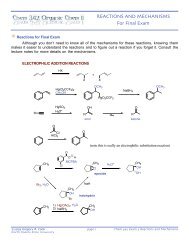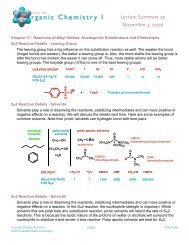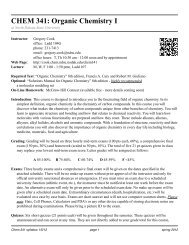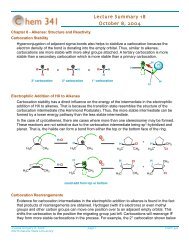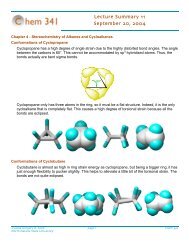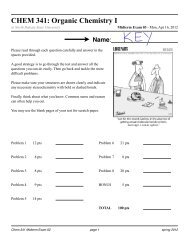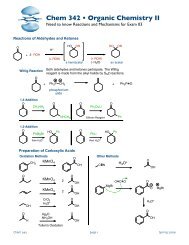Chem 342 ⢠Organic Chemistry II
Chem 342 ⢠Organic Chemistry II
Chem 342 ⢠Organic Chemistry II
You also want an ePaper? Increase the reach of your titles
YUMPU automatically turns print PDFs into web optimized ePapers that Google loves.
Suggested problems from your text:<strong>Chem</strong> <strong>342</strong> • <strong>Organic</strong> <strong>Chem</strong>istry <strong>II</strong>Suggested Problems for Chapter 13 13.3, 13.6, 13.7, 13.8, 13.10, 13.14, 13.17, 13.19, 13.20, 13.21, 13.23, 13.25, 13.26, 13.32, 13.33, 13.35, 13.38, 13.40,13.41, 13.43, 13.44, 13.47, 13.49, 13.50, 13.52, 13.54, 13.56, 13.58, 13.59Additional Practice Problems:1. How many degrees of unsaturation does a molecule with the formula C11H13N2Cl have?2. Which of the following sets of data would match the proton NMR of ethanol (CH3CH2OH)?a) 1.2 ppm (triplet, 3H); 2.6 ppm (singlet, 1H); 3.8 ppm (quartet, 2H)b) 1.2 ppm (quartet, 3H); 2.6 ppm (singlet, 1H); 3.8 ppm (triplet, 2H)c) 1.2 ppm (singlet, 3H); 2.6 ppm (singlet, 1H); 3.8 ppm (singlet, 2H)3. Use the following 1 H and 13 C NMR data to determine the structure of a molecule with themolecular formula C10H12O.<strong>Chem</strong> <strong>342</strong> page 1 Spring 2009
4. The three compounds shown below, ortho-, meta-, and para-xylene have very different 13 CNMR spectra. Match the structures with the correct spectra.CH 3CH 3CH 3CH 3H 3 CCH 3ortho-xylene meta-xylene para-xyleneA B C<strong>Chem</strong> <strong>342</strong> page 2 Spring 2009



